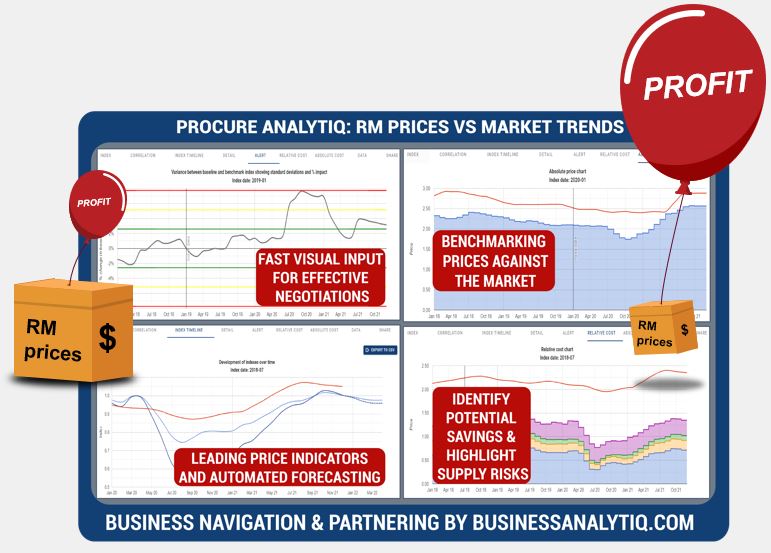Single superphosphate (SSP) price April 2024 and outlook (see chart below)
- North America:US$0.18/KG, unchanged
- Europe:US$0.47/KG, -2.1% down
- Northeast Asia:US$0.43/KG, unchanged
Business Analytiq assumes no responsibility or liability for any errors or omissions in the content of this site. The information contained in this site is provided on an “as is” basis with no guarantees of completeness, accuracy, usefulness, or timeliness.
Single superphosphate (SSP) price index
This post is a summary of the Single superphosphate (SSP) price developments. The price developments of Single superphosphate (SSP) are expressed in US$ prices converted FX rates applicable at the time when the price was valid. Single superphosphate (SSP) price index developments are calculated from multiple separate sources of data to ensure statistical accuracy.
The outlook for Single superphosphate (SSP) prices, on the second tab, is generated from different inputs including:
- Very recent price developments of immediate cost drivers of Single superphosphate (SSP) prices
- Recent price developments of underlying feedstocks which drive the price of Single superphosphate (SSP)
- Market futures for both cost drives and feedstocks of Single superphosphate (SSP) prices
- Adjustment of current supply/demand imbalances in the Single superphosphate (SSP) market
- Longer term trends in likely demand conditions
Further information on the Single superphosphate (SSP) price index
What is Single superphosphate (SSP)
Single superphosphate (SSP) is a type of fertilizer that is produced by treating phosphate rock with sulfuric acid. This process creates a mixture of monocalcium phosphate and gypsum, which is then dried and ground to form SSP.
SSP is a widely used fertilizer due to its high content of phosphate, which is an essential nutrient for plant growth. It is often used on crops that require high amounts of phosphorus, such as corn, potatoes, and wheat.
One of the advantages of SSP is that it is relatively inexpensive compared to other phosphate fertilizers, such as diammonium phosphate (DAP) and triple superphosphate (TSP). However, SSP does have some disadvantages, such as its lower phosphorus content compared to other fertilizers, as well as the potential for sulfur buildup in soils with repeated use.
How is Single superphosphate (SSP) produced
Single superphosphate (SSP) is typically produced by reacting ground phosphate rock with sulfuric acid in a reactor vessel. The resulting reaction produces a mixture of monocalcium phosphate and gypsum, which is then dried and ground to create SSP.
The production of SSP typically involves the following steps:
Mixing
The ground phosphate rock is mixed with sulfuric acid in a mixer to create a slurry.
Reaction
The slurry is then transferred to a reactor vessel, where the reaction between the phosphate rock and sulfuric acid takes place. The reaction produces a mixture of monocalcium phosphate and gypsum.
Filtration
The mixture is then filtered to remove any solid impurities.
Drying
The filtered mixture is dried to remove any remaining moisture.
Grinding
The dried mixture is ground to a fine powder to create SSP.
Storage and packaging
The final product is then stored and packaged for distribution to customers.
It is worth noting that the quality and purity of the phosphate rock used in the production process can affect the quality of the SSP produced. Additionally, the process may produce some waste materials, which need to be properly managed to prevent any adverse environmental impacts.
What types of SSP are there
Single superphosphate (SSP) is typically produced in two forms, powder and granular. Both types contain the same chemical composition, but they differ in terms of particle size and physical properties.
Powder SSP
This is the most common form of SSP and is produced by grinding the dried mixture of monocalcium phosphate and gypsum into a fine powder. Powder SSP is typically more uniform in size, making it easier to handle and distribute. It is commonly used in dry fertilizer blends or can be applied directly to the soil.
Granular SSP
This form of SSP is created by taking the powdered form and then granulating it into a larger particle size. Granular SSP is generally easier to handle and apply than the powdered form because it can be easily spread using standard fertilizer equipment. It is also less prone to dusting and provides a slower release of nutrients compared to powder SSP.
There are also different grades of SSP based on the percentage of phosphorus content. For example, standard grade SSP contains about 16% phosphorus, while high-grade SSP contains around 20% phosphorus. The grade of SSP used will depend on the specific needs of the crop being grown and the soil conditions.
How big is the Single superphosphate (SSP) market
According to a report by Mordor Intelligence, the global single superphosphate (SSP) market size was valued at approximately USD 4.2 billion in 2020, and it is projected to reach a value of around USD 5.7 billion by 2026, growing at a CAGR of approximately 5% during the forecast period.
The growth of the global SSP market is driven by factors such as increasing demand for food due to population growth, rising demand for high-value crops, and increasing awareness of the benefits of using fertilizers for plant growth. The market is also influenced by various factors such as changing weather conditions, fluctuating commodity prices, and government regulations.
According to https://oec.world/ :
Superphosphates, in packs >10 kg are the world’s 1807th most traded product.
In 2020, the top exporters of Superphosphates, in packs >10 kg were China ($294M), Morocco ($263M), Israel ($183M), Egypt ($93.2M), and Netherlands ($57.3M).
In 2020, the top importers of Superphosphates, in packs >10 kg were Brazil ($321M), United States ($81.9M), France ($66.5M), Indonesia ($62.7M), and Australia ($34.3M).
Which countries produce the most SSP
The production of single superphosphate (SSP) is widely distributed globally, with many countries producing it. However, I can give you some of the largest producers of SSP based on the latest available data:
India
India is the largest producer of SSP in the world, with a production of around 7.3 million tons in 2020. India has a significant demand for SSP due to its large agricultural sector, and the country also exports a considerable amount of the fertilizer to other countries.
China
China is the second-largest producer of SSP, with a production of around 4.4 million tons in 2020. China has a large agricultural sector, and the demand for SSP is high due to the need to increase crop yields and productivity.
Morocco
Morocco is the third-largest producer of SSP, with a production of around 1.4 million tons in 2020. Morocco is a major exporter of phosphate rock, which is a key raw material used in the production of SSP.
Pakistan
Pakistan is the fourth-largest producer of SSP, with a production of around 0.9 million tons in 2020. Pakistan has a large agricultural sector, and the demand for SSP is high due to the need to increase crop yields and productivity.
Other significant producers of SSP include the United States, Brazil, Russia, Australia, and Ukraine.
Further reading
Business Analytiq
BE THE FIRST TO SEE RISK AND OPPORTUNITY!
BusinessAnalytiq provides unlimited market trend data and an online tools to track market developments, key benchmarks & leading indicators.
BusinessAnalytiq leads to price visibility, better negotiations, easier budgeting and forecasting, lower raw material prices, and improved better internal and external communication. BusinessAnalytiq will decrease risk and higher profit.

Where does the data come from?
- The source of the data are exclusively public non-confidential sources. We have no access to primary data
- This the index trend of the price trend of the "product category" in general, and not a single specification of the product in particular
- The data is a combination of contract and spot pricing
- Our algorithms are set up to eliminate significant product mix impact on the reported price
- We combine public publications, import/export records, trading prices, company announcements, magazine articles, tweets, and other sources of ad-hoc public information.
- The chart shows the our best approximation of the market trend based on our algorithm interpretation of the signals
- For most indexes we have multiple sources and we focus on using statistically-correlated sources
- As a function of our automation, it is likely that recent trends will be adjusted as we discover more information. So, for example, the price trend for February 2024 will be first calculated in February 2024 and adjusted in March, April and May 2024.
- We will update the data trend as more information becomes available, and this means that recent trends will always be adjusted as we get more data available
- The algorithm will regularly revise our understanding of market trends, and indicated market trends may change
- The data is presented in US$. The UOM of measure is shown in the Index list table
- Our automated software and we do our best to create an accurate representation of the trend
Where does the data NOT come from?
- We do not purchase data from any other source and republish it.
- We will not purchase data from any other source and republish it
- We do not extrapolate trends, even for the forecast. We look for other market signals and leading indicators
What data should our company use?
- If you are making decisions driving significant share of profit, we always recommend that you buy data from the companies who invest in direct primary market access such as ICIS, amongst many others
- Our data, at best, represents an estimate of the market trend based on public information
- We have no direct access to the market, and we do not interview suppliers and customers
- Our automated analysis tools in the online software are set up to combine our data with other sources of data
- We do not recommend that you use our data for direct price mechanisms, as we may change and improve the data trends over time, including historical data
What does the quality indication in the main menu mean?
- Quality level A: Data is from a reliable and confirmed source
- Quality level B: Data is from multiple credible sources and there are no major statistical inconsistencies between them
- Quality level C: Data is from multiple credible sources and there are some statistical inconsistencies between them
- Quality level D: Data is from a single credible source, but we cannot verify the data
- Quality level E: Data is either:
- From a single source, which we consider reliable, but we cannot verify the data.
- From 2 or more sources which have some periods of contradicting trends.
- Quality level F: Data is from a single source which we consider indicatively correct, but the data is anecdotal and we cannot verify the data.
What are the disclaimers?
- We assume no responsibility or liability for any errors or omissions in the content of this site.
- The information is provided on an “as is” basis with no guarantee of completeness, accuracy, usefulness, fitness for purpose or timeliness.
- By their nature, outlooks are always uncertain
How often do we update the data?
- We aim to update the data series on the 9th and 24th of each month (but we do not always make it for each chart)
- The data for the current month and recent history are fine-tuned over time.
What are we doing to improve the data?
- We are continually improving our data collection and processing methods
- Pricing data will be updated from time to time as we improve the accuracy
- We are reviewing all data sources in the first half of 2024.
- There will be continuous fine-tuning of the trend and forecast algorithm as part of that.
- The key focus in 2024 is to add many additional indexes
How can i give feedback on the data or request for new indexes
- Feel free to contact us if you have a specific request. You can reach us via the Contact us page

